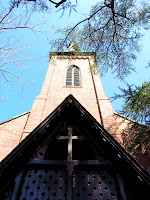One recommendation I do have after doing all of this... MAKE SURE YOU HAVE ENOUGH SPACE TO HANG IT!!! I made this picture into a 4'x4' painting. With all of the work on my walls already I can't find a place to hang this huge piece. But it is rather nice though, definitely worth the effort.
Enjoy, I will definitely be doing the gridded enlargement again, I love the results! I have been a critic of this form of drawing because it seems so labor intensive. But when doing something as intricate and precise as portraiture it is extremely necessary. Freehanding this would have not been nearly as successful.
I am starting to do some photography of around town and of my travels. I am playing with macro in floral photography and some architectural studies.
Another thing that I'm learning is photo editing. I just learned how to correct photos. I was able to remove a huge lightpole out of the middle of this picture, although I screwed up and saved over the original so I don't have the original reference picture.
 |
| This is the edited photo, there was a huge light pole in the center. Now it's GONE! |
Sunsets are gorgeous and they go fast, so if you see one take the time, stop and get it on film. I drove from one side of town to the other, it took 15 minutes and by the time I got home the light was gone. It's probably not a good idea to drive and snap pictures, but thank goodness for stoplights.


















































